 router
router 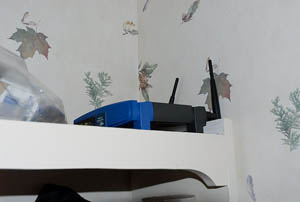
In July 2008 I switched from DSL from a local provider that I've had for about 9 years to Verizon FiOS. This is the story of the switch. Note that Verizon in the region was sold to Frontier Communication and in 2020 to Ziply Fiber.
To get the proper perspective, first consider the history.
I had DSL since around when it was first available here. Aracnet (which became SpiritOne and is now defunct) was my ISP, with the connection, tariffed at business rates, provided by Verizon. While it was confusing dealing with two providers, it actually worked well. Verizon at the time provided a local phone number for service which was answered by a human. Speed was 256k down and 64k up (guaranteed), later enhanced to 768k down and 128k up ("up to" specs on both). I paid about $50/month for the service when I started and $26/month when I terminated. This was on 1 year contracts. One nice feature was it included a static IP address.

Unlike most DSL installs people have, this required professional installation. Filters were installed in my termination box with one pair in the house for voice and the second for data. My house had been wired for five phone lines, so this was a particularly easy change.
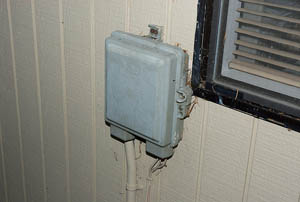
My office is in the center of the house, and the "DSL MODEM", actually the DSL Bridge, was located there. I used my windows computer as a router, installing two NICs to do this. With the second line going to my wife's computer via thinwire (10BASE2, a coax network). Over time the local network grew and was modernized. Before the switchover to FiOS, the bridge connected to a LinkSys WRT54-G router and wireless access point. This plus an additional switch provided networking via wireless and wired 100Base-T to:
An older Dell Inspiron notebook could not be connected wirelessly because it didn't support WPA encryption, and I switched from WEP to WPA for security. Also it is claimed that the wireless network works better if it is running G only, with B turned off.
Whenever somebody at Verizon called to sell me DSL (funny since I had it already), I'd ask them if it was for FiOS and said to call me back when they had FiOS. We got an EMAIL when FiOS was available and I ordered that day, with a 7 business day wait for installation. Not bad really.
Prior to the installation then sent a technician out to check the site. He said the equipment could be installed either in the house (usually by the existing telephone termination) or in our garage, which is on the opposite side of the house. Naturally, I wanted the garage installation. No problem.
The day before the installation a crew of two men came out to install the fiber from the street to the house. The street termination is on the right of the house but the garage is on the left. So the buried the cable (digging the trench by hand!) from the street...
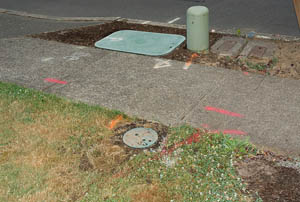
...to the right of the house...
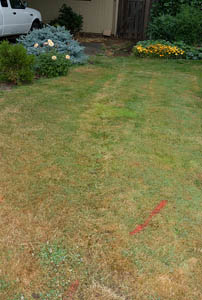
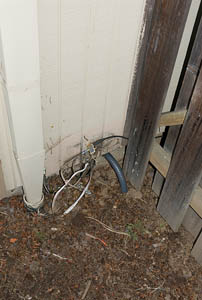
...through the house to the left side...
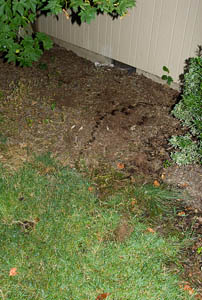
...looped through the left yard (digging another trench)...
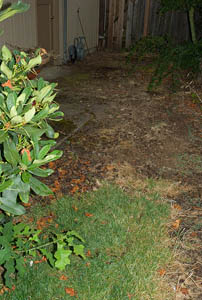
...and up to the garage by the power utility service entrance.
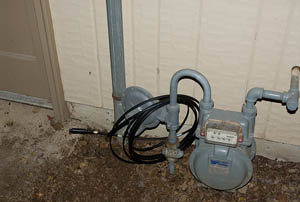
They left a pull string through the house so that the service cables could be pulled back through the house since the phone box and the (former) cable TV service enter on the right. They took three hours to do this work.
I must hand it to the Verizon personnel for offering this installation which is superior for me while it used far more fiber, wire and their labor than just putting everything on the right side of the house.
The installer was upset. Why did they run the fiber through the house to the other side rather than terminating it on the right. After all, the telephone termination was there. After an explanation of what I wanted, and showing the pull string I convinced him to go ahead. He later commented that it was an easy install.
In a process that took him 4 hours (ten hours of Verizon labor total) he mounted the box with the termination and battery backup in the garage...

...ran telephone wire (he simply used Cat-5E cable) back under the house to the termination box, ran Cat-5E part way under the house and into my office, and ran coax, unterminated at both ends, under the house for future FiOS TV. Then he connected everything up. The fiber termination box (called the ONT -- Optical Network Terminal) has connections for multiple telephone lines, 100Base-T for Internet, and coax for TV.
Nothing seemed to work at first, leaving me worrying about future reliability. The telephone service was dead to half the house (there are two wires entering with the second to an addition) but he got that going. I could talk to the Actiontec router they supplied, but couldn't go out beyond.
I wish he would have explained about the TV coax before he installed it. We only have a single TV, which is located one room away from the fiber termination! It currently connects via a separate coax system to a DirectTV dish. Running TV coax to the cable TV entry will do nothing useful!
Apparently early FiOS installations used the router to separate the TV signal from data. Now that is done at the ONT. Not only is that cleaner, but the TV service won't go down if the router fails or is replaced. Even though Verizon states you have to use their router, apparently others can be used, although there may be bandwidth limitation problems. I expect there would be with my old, slow Linksys WRT54G.
With a Mac there was basically nothing I had to do to get Internet service, and they provide no software for Mac users. However things were not problem free. While they officially support Mac users, when I asked about setting up my email address I hit a wall -- the website that enrolls you is only compatible with Windows! Why would this need an Active-X control? I was to find out.
The installer left at this point, leaving me to my own devices. We will ignore that the installation service includes setting up one computer (with more at additional charge) since I wouldn't want him to be fooling with my computer anyway!
I could reach the router but not beyond at first because my computer was configured with a static IP which the router did not like. So rather than reconfiguring the router (which I knew I would eventually need to do) I first reconfigured my Mac to use DHCP. The Internet suddenly appeared! I went to the Verizon website to get my email set up and found that neither Safari nor Firefox would work. It was that stupid Active-X control.
I now made my first mistake. I used Windows Remote Desktop to get to my server to get my EMAIL set up from there. But the browser wouldn't work -- it was the static IP problem again! So I thoughtlessly changed it to DHCP. Bye-bye server! Not knowing its new address, I couldn't reach it anymore.
So I did what I should have in the first place, use a Virtual Windows machine under Parallels on my Mac. Turns out this is an especially good idea if you aren't particularly careful. The reason for that Active-X control is so that they can install software on your machine! I unchecked all the options, so presumably nothing was installed, but just a word of warning because the default will install lots of questionable stuff.
With the email address set up, I started Mac Mail and went to add the server. Mail recognizes the verizon.net domain and offers to set up the account automatically. DON'T DO IT! It uses the wrong server name! Looks like they used to use Yahoo mail but now have their own server, or at least their own server name. It didn't work at first. I guess there was just a delay between setting up the account and the actual activation.
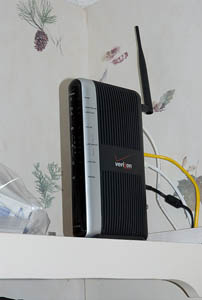 Actiontec Router MI424WR
Actiontec Router MI424WR
The Actiontec router, an OEM model made for Verizon, is actually very nice. But the menu structure seems disorganized. I could get around my old Linksys router much easier. It took a while to find where I could set the DHCP dynamic address range to exclude a few for my static IP systems, but when I did that problem went away. How did I find where my server was? Well the Actiontec also maps out the systems it sees. Looking at the list told me what IPs to try in Remote Desktop so I could connect and restore the static IP. I set a new router name and login name/password. I set the passthrough ports -- they provide a menu of common services to make this easy, although, amusingly, "Bittorrent" was missing from the list.
Speaking of which, the Actiontec router is customized by Verizon to have a reduced number of simultaneous connections -- 190 compared to 252 or 254 for other Actiontec models. This might crimp the style of a major P2P fanatic, but I didn't see any problems with my usage patterns.
On the plus side, the Actiontec came configured with wireless encryption turned on, with the password printed on the router. Inexplicably, it was set for WEP. I had to change it to the much more secure WPA. Why? The radio signal is much stronger than the Linksys it replaced. It works well.
I ordered the slowest service, 10Mbps down and 2Mbps up and it does slightly more than 10 down and does about 1.8 up. Pretty decent. The Apple website has a utility program that reconfigures the network interface for larger buffer sizes which is supposed to improve performance with FiOS. I could see no difference, but I left the patch in place. The living room system streams Netflix movies very well. Before the switch it was problematic.

I still need to get set up with Dynamic DNS since I no longer have a static IP. And it will take time before I know about reliability. The Prevailing Wisdom seems to be that FiOS is very reliable but the Actiontec router isn't.
I got my home domain name back by signing up with dyndns.org (for free), installing IP monitoring and reporting software on my server, and pointing a "C" record for my home subdomain to the dyndns.org assigned name. It all works, and it's free.
Another goodie about the Actiontec router is that it does local name serving, which the Linksys didn't do. This means that I can access any of my local systems by name. I don't need the static local IPs (and entries in the host files) anymore!
It looks like Verizon's installations are constantly evolving. I people needed the router to provide television access. This install didn't need that, being data only. But after doing some reading it looks like they will eventually distribute services through the house over a single coax. The router already supports coax on the WAN side. And there are ONTs made that supply all services via coax. This would greatly simplify most installs where multiple services are involved, saving Verizon money.
Verizon states they don't allow going back to DSL and copper service after changing to fiber. And they did pull all the filters and termination blocks out of the telephone termination box. However I've read that they cannot legally disconnect if other services are provided over the wires (since the wires by law must be available to third parties). Well they goofed here in my case because I had not disconnected from my Spiritone DSL service. It was still running at the CO end and I was still paying for it when the installer ripped it out! Strictly hearsay, I've heard of cases where existing cable TV service lines were "accidentally" broken during FiOS installs, and copper service lines completely removed. You might want to approach a switch to FiOS with some caution.
It's now the case that I can get FiOS HD TV service with a DVR for less cost than I was paying for DirectTV with a Tivo (but standard definition). So I made the change. The Tivo DVR is much better, alas. But the package included a speed upgrade to 20 MBPS down and 5 MBPS up.
To install, the Actiontec router now takes on a mysterious roll. Both it and the TV (I've only got one) are connected to the ONT via coax. There is a splitter at the ONT. The Cat-5e from the ONT to the router is still used for data, so there is both data and TV signals going between the ONT and the router. Naturally they cut the coax to the DirectTV dish, rendering that useless. That seems to be Standard Operating Procedure for Verizon.
So the question is why didn't they connect the router via coax before? Anyway, now if the router goes down the TV apparently goes away as well as it loses the guide data.
Again there is some local configuration that they do needing a Windows PC. So I first started up Windows under Parallels on my iMac. There software wouldn't work because it didn't recognize the network adapter (really touchy software for some reason). So I started up Windows Remote Desktop so they could run their software on my Windows XP server. It didn't run their either because the system had a static IP address. Seems their install program is pretty stupid and only works in Verizon configuration. So they had to dig out their own notebook computer and use that.
The connection speed did not improve. Somehow the order was lost. And even though technical support could see that I was supposed to have 20/5 but didn't, they couldn't do anything without the order. The order department couldn't order it apparently because I already had it. After several days of nonsense they finally dropped my service to a lower level on one day and then raised it again on the next. Every service change, even those that did not occur, would trigger a pair of snail mails from Verizon and a pair of emails (one to the address I gave them and another to the Verizon email address that I don't use) telling me I had to go online and accept their terms of service. Quite an idiotic operation. And I'm shuttering to think about what my bill will look like.
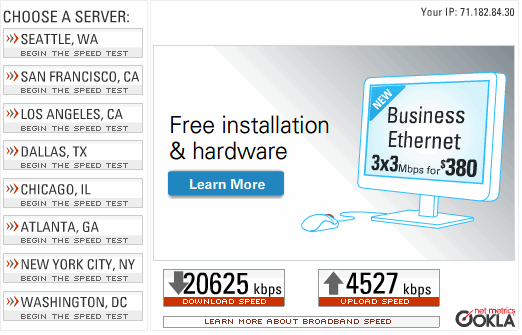
The bill came and there were 74 line items! But it all checks out. Except they billed me in three payments a total of $110 to install two TV jacks. Strange since I only have one TV, and stranger since they used an existing DirectTV jack! I had no problem getting that removed, but a word to the wise to check their bill carefully!
The Actiontec router is generally performing well but occasionally would need to be power cycled. Somehow it gets into a mode where wireless computers can't see any other systems on the LAN but only have Internet access. That would be great for guests, but is a problem for general use (I can't get to my printer or server). There doesn't seem to be any setting for this either.
The extra power of these routers is probably more of a curse than a blessing, and the power cannot be turned down to reduce interference. I had probably the first WIFI on the block, but I recently counted 11 networks visible from within my house. Six of them were Actiontecs (FiOS is getting popular), all set to their default channel 6.
Disgusted with the problems, I bought an Apple Airport Extreme which I use as a wireless access port, only. I disabled the WAP in the Actiontec. After upgrading a NIC and replacing some CAT5 wire with CAT5e I now have N wireless for my notebook and gigabit Ethernet between my main computer and the server. And all my wireless issues have gone away.
I upgraded the service to 25/25, although I've found the 25 up speed to be somewhat sporadic. I also had a wiring failure this Fall, but otherwise it still continues to be a reliable setup.
I upgraded the service to 50/50. The down speed is a bit shy but the up speed is always better than promised.

The router was no longer bundled (after the 50/50 upgrade) so I finally returned it (no more Actiontec!) and got a Unifi Security Gateway.
I noticed that in the past two months my Ziply bill said I had 100/100 service. There was no price increase. Apparently 100/100 is now the baseline service. However I didn't notice any change so I gave them a call. No hold time on the phone (!) and they scheduled a truck to come out a replace the ancient ONT with one that supports 100/100 service. Less than 24 hours after the call I'm now getting this:

That is with a TV streaming in another room, so the down speed is actually a few Mb/s faster.
What gets me as an interesting coincidence is this week T-Mobile is "upgrading" everyone with old plans to new plans at a higher price. I will have to call (along with millions of other customers) to keep the older plans which were just fine. These plans were billed as life-time with no price increases. Kudos to Ziply. Boos to T-Mobile.
See the server page for my LAN configuration as well as current pictures.
|
Tom Almy webmaster9@almy.us |
Last Modified October 2023 |
| Return to my HOME PAGE | |